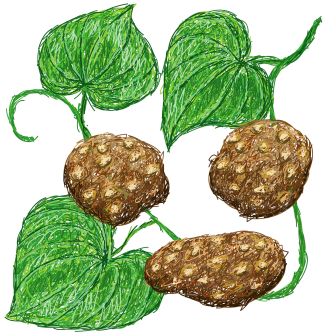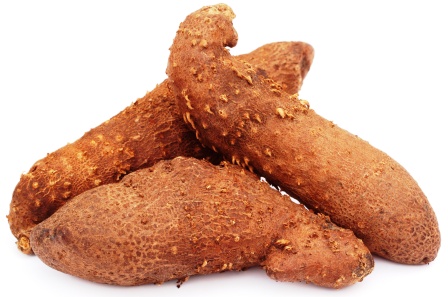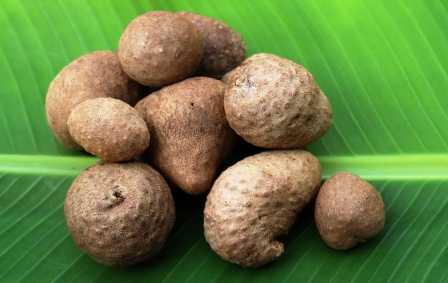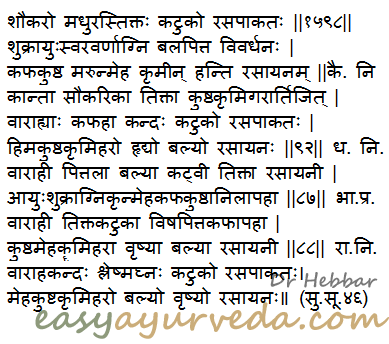Dioscorea bulbifera – Air Potato Uses, Research, Side Effects
Varahikanda – tuber of Dioscorea bulbifera is an excellent aphrodisiac herb, used for the treatment of diabetes, eczema, psoriasis, intestinal parasites etc. It is also called air potato.
Botanical name- Dioscorea bulbifera Linn, Dioscorea sativa,Linn.
Family- Dioscoreaceae (Varahi kula)

Table of Contents
Vernacular names
Names in different languages:
English name – air potato, potato yam.
Hindi name – Suralu, Zami kanda, Gaithi, Genthi, Barahi khandh, Barahikhandha
Gujarati name – Dukar kanda, Dukkar Kand, Suvariya, Dukkar Kand.
Kannada name – Heggenasu, kuntu genasu.
Malayalam name – Kattu kachi, kattu kachil.
Tamil name – Pannu Pilangu
Telugu name – Nela dumpa
Bengali name – Banalu, pitalu.
Konkani name – Karamdo.
Marathi name – Gathalu, Manu kand, Gorkan, Kukar Kand
Oriya name – pitalu.
Assamese name – Kathalu, Mati alu.
Japanese name – Benkei imo.
Chinese name – T’u uh, un kau tou.
Sanskrit synonyms
Varahi : “Varahasya iyam priyatvat iti Varahi” – It is dear to pigs.
वराहमूर्धवत्कन्दो वाराहीकन्दसंज्ञकः | Bhavaprakasha
Its tuber resembles the face of a pig (Varaha). This has synonyms such as Shukara, Sukari, for the same reason. (Shukara is a synonym for pig).
Grushtika, Gusthi : “Garshati hinasti rogan” – That which cures diseases.
Vriddhida: That which causes increase of dhatus.
Veera: That which makes person brave i.e. potent.
Maha virya/ Maha aushadhi: That which is a highly potent medicine
Amruta: That which is nectar like.
Magadhi: That which grows in magadha region.
Vanya, Vanamalini : That which grows abundantly in the forest.
Vara – Vara means great. It is a great anti-aging and rejuvenating herb.
Mahaveerya, Mahaushadhi – very potent medicinal herb
Kharakanda – the tuber has rough surface
Kachi, Chakralu, Shabarakanda, Kirimoolaka, Vishvaksena Kanta
Brahmaputri, Madhaveshta

Chemical constituents
Dioscorea bulbifera chemical Constituents-
Three furanoid norditerpenesdiosbulbins A,B,C,D,E,F,G,H; diosbulbinosides.
Classical categorization
Bhava Prakasha-Guduchyadi Varga
Kaiyadeva-Aushadhi Varga
Priya Nighantu.-Pipalyadi Varga
Raj Nighantu-Mulakadi Varga
Shaligrama Nighantu-Saka Varga
Dhanvantari Nighantu – Karaviradi Varga
Systemic classification
Kingdom-plantae-(plants)
Subkingdom – Tracheobionta-(vascular plants)
Superdivision – spermatophyta-(seed plants)
Division – Magnoliophyta-(flowering plants)
Class – liliopsida – (monocotyledons)
Subclass – liliidae
Order – liliales
Family – Dioscoreaceae-(yam family)
Genus – Dioscorea-(yam)
Species – Bulbifera-(air yam)
Properties, part used, dosage
Dioscorea bulbifera medicinal Properties
Guna (qualities) – Laghu – light to digest, Snigdha – unctuous, oily
Rasa (taste) – Madhura – sweet, Katu – Pungent
Vipaka- Katu – Undergoes pungent taste conversion after digestion
Veerya – Ushna – Hot potency

Effect on Tridosha – Balances Kapha Dosha and Vata Dosha. Slightly increases Pitta Dosha.
Prabhava – Special effects:
Rasayana – anti aging, causes cell and tissue rejuvenation
Vrushya – aphrodisiac, improves vigor
Part used- Tuber, bulbils
Dosage-3-6 g per day
How to take it?
The tubers are administered directly or made into choorna & administered in a dose of 3 – 6 grams per day, with milk as Anupana.
Sanskrit verse

Uses, indications
Varahikand – Dioscorea bulbifera uses:
Shukravardhana – improves sperm and semen quantity and quality
Ayurvardahana – Rasayana – anti aging, causes cell and tissue rejuvenation
Svaravardhana – improves voice, useful in throat infection and related disorders
Agni Vardhana – Due to Katu Vipaka (taste conversion after digestion), it improves digestion strength
Balavardhana – improves strength and immunity
Kaphahara – balances Kapha, useful in productive cough, asthma, bronchitis, chest congestion
Vatahara – useful in treating disorders of Vata Dosha imbalance such as neuralgia, paralysis, constipation, bloating, etc
Hrudya – acts as cardiac tonic, congenial for heart
Indicated in :
Kushta – skin diseases
Meha – diabetes, urinary tract disorders
Krumi – worm infestation
Garavisha – chronic poisoning
Arti – relieves aches and pain
Therapeutic uses
As rasayana
Powder of varahi tuber mixed with honey is suspended in milk and taken after it is eligested milk, ghee and boiled rice should be taken as diet(s.s.ci.27.11).
Fresh varahi tuber should be taken with milk keeping on milk diet without cereals for a month and then for the next month on milk and cereals(A.H.U.39.58-59)
Those of wild form are bitter and acrid, but can be rendered edible by coursing with ashes and steeping in cold water(D.G.S.P V Sharma)
Sinus – Nadi vrana
Varahi tuber should be mixed with oil and then applied to the sinus(S.S.Ci.17.36).
External application:
Ulcers and wounds – The dried powdered tubers are used as an external application for ulcers. They are also used to treat piles.
Side effects, substitute
Side effects of Varahikanda –
Because it can slightly increase Pitta Dosha, people with Pitta body type or Pitta imbalance should avoid it or take it along with milk to nullify Pitta effect.
There is a research article citing its hepatotoxicity. Hence, overdosing should be avoided.
Substitute
Acharya Vrinda has mentioned charma karaluka as its substitute.
Varahikanda is used as a substitute for Riddhi and Vriddhi drugs of Astavarya in Ayurveda.
Because it is used as a substitute for 2 of Ashtavarga herbs – Vruddhi and Riddi, it is used as an ingredient, wherever these two herbs are used – as in Chyawanprash, Dasamoolarishtam etc.
Interaction with medicines, supplements
Can this be used while taking Homeopathic medicine?
Yes. This product does not react with homeopathic medicine.
Can this medicine be continued while taking supplements like multivitamin tablets, Omega 3 fatty acids etc?
Yes. Generally, this product goes well with most dietary supplements. However, if you are taking more than one product per day, please consult your doctor for an opinion.
With western
medicines
Seek your
doctor’s advice if you are taking this product along with other western
(allopathic / modern) medicines. Some Ayurvedic herbs can interact with modern
medicine.
If both Ayurvedic and allopathic medicines are advised together, then it is
best to take Allopathic medicine first, wait for 30 minutes and then take the
Ayurvedic medicine.
Research
Synthesis of silver nanoparticles using Dioscorea bulbifera tuber extract and evaluation of its synergistic potential in combination with antimicrobial agents – Development of an environmentally benign process for the synthesis of silver nano-materials is an important aspect of current nanotechnology research. Among the 600 species of the genus Dioscorea, Dioscorea bulbifera has profound therapeutic applications due to its unique phyto-chemistry. In this paper, rapid synthesis of silver nanoparticles by reduction of aqueous Ag+ ions using D. bulbifera tuber extract was reported.
Screening of antioxidant potentials –
It is traditionally used to lower glycemic index, thus providing a more sustained form of energy and better protection against obesity and diabetes. It also has anti-cancer properties. The present study was undertaken to investigate the antioxidant activity of Dioscorea bulbifera. The ethanolic extracts of tuber Dioscorea bulbifera were screened. The results have good significance, as this increases the innate antioxidant potential of Dioscorea bulbifera, which is useful in providing the antioxidants needed in the diet and thereby Dioscorea bulbifera accomplishes high value nutritive and natural store of antioxidants.
Synthesis of silver nanoparticles using Dioscorea bulbifera tuber extract and evaluation of its synergistic potential in combination with antimicrobial agents
Ayurvedic medicines
Ayurvedic medicines with Air Potato as ingredient:
(Click on the medicine name to know more about them).
Ajamamsa Rasayanam – It is a very famous Ayurvedic medicine. It is prepared both in herbal ghee or herbal jam form. It is used in treatment of Vata disorders like loss of strength, hemiplegia etc. Ajamamsa means goat meat. It is a non vegetarian Ayurvedic medicine.
Narasimha Churna – It is used in the Ayurvedic treatment for a wide variety of diseases such as respiratory conditions, male infertility treatment, etc.
Pancha Nimbadi Churna – It is used in the treatment of eczema, psoriasis, sinus, fistula, diabetes, etc.
Mention of Varahikanda in Ayurvedic text books:
Charaka only mentioned it as Sukari, as an ingredient of Mahapaishachika Ghrita (Charaka Chikitsa 9th Chapter – Unmada Chikitsa)
Sushruta used the synonym “Sabara Kanda” and also mentioned it as Varahi and Gostika (s.s.ci.9\9). He mentions it as Rasayana(s.s.ci.27\11).
Vagbhata quoted the term Varaha Kanda and also mentioned the term Varahi.
References in Ayurvedic text books:
Brihatrayis
- Charaka only mentioned it as Sukari(c.s.ci-9/53).
- Sushruta used the synonym “Sabara Kanda” and also mentioned it as Varahi and Gostika (s.s.ci.9\9). He mentions it as Rasayana(s.s.ci.27\11).
- Vagbhata quoted the term Varaha Kanda and also mentioned the term Varahi.
- Laghutrayis
There is no reference in laghutrayis except Bhava prakasha where author has mentioned its synonyms, properties and functions. - Nighantus
- Raja nighantu has given its synonyms, guna, and karma.
- Priya nighantu mentioned its synonyms and guna.
- Kaiyadeva nighantu mentioned synonyms along with guna karma.
- Bhava prakasha nighantu mentioned synonyms, morphology, guna, prayoga and quantity used.
- Dhanvantri nighantu mentioned synonyms and uses.
- References of synonyms, guna and karma are also found in Siddha mantra nighantu, Shaligram nighantu, Madanapala nighantu.
Morphology
Twinning perennial herb, tubers are solitary, globose o pyriform covered with long roots
Leaf – Alternate, broadly ovate – cordate
Fruit – Capsule, oblong three winged
Seeds – Winged at one end
Useful part – Tuber – Tubers are potato like and attached to the stems. grayish in color, somewhat irregular in shape. Tubers grown underground are large in size
Substitute
Tacca aspera
Sthanika Karma (Systemic Action)
External use
Wound healing, Oil is indicated in Nadi vrana
Internal administration-
Digestive System – Carminative, digestant, Anti helminthic. indicated in abdominal colic, loss of appetite etc.
Excretory System – Indicated in diabetes
Circulatory system – Acts as a blood purifier, Indicated in cervical lymphadenopathy
Reproductive system – Aphrodisiac
tvak – indicated in skin disorders, STD’s etc.
Satmikarana – Indicated in general debility, rejuvinative.











One comment
Srinivas
Nice website, illustrated about varahi kandha